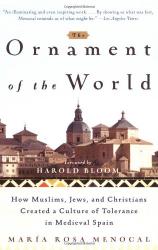Reading Group Guide
Discussion Questions
The Ornament of the World: How Muslims, Jews, and Christians Created a Culture of Tolerance in Medieval Spain

1. Did reading The Ornament of the World in any way change your view of the Middle Ages? How? Why do you think the perception of the Middle Ages as a dark and benighted era has persisted over the centuries?
2. What features does the Quran have in common with the scriptural texts of the other two "Peoples of the Book"? In what ways do the three scriptures differ? Discuss the role that pre-Islamic poetry played in the creation of a certain poetic ethos in Arabic culture.
3. What are the origins of the dhimma statutes in Islam and why were they so crucial during the years of the expansion of Islam? Are there comparable regulations regarding other faiths in either Judaism or Christianity?
4. Discuss the reactions of the Christian and Jewish communities to the arrival of Islam in the Iberian peninsula. Why did these two communities react so differently to what was, in effect, the same level of protection afforded them as dhimmi communities? What might explain the very high rate of conversion among Christians?
5. The years of relative political chaos that followed the dissolution of the caliphate were years of increasing cultural riches. Discuss the seeming paradox of the positive effects of the disintegration of the caliphate. Can you think of other historical moments characterized by political instability that produced comparable cultural flowering?
6. How and why did the translation movement, especially the stage during which the sciences and philosophy were the principal texts being translated, change the landscape of northern Christian Europe? What problems did the arrival of the Greek philosophical tradition pose for the three monotheistic traditions, and why? How have these same problems —the opposition between faith and reason, as many would see it —continued to shape Western civilization since the twelfth century?
7. Discuss the shifting attitudes on the part of the ruling Christians from the beginning of the thirteenth century on. What role did the Almohads play in this period?
8. Consider the construction of so-called mudejar (i.e., "in the Arab style") palaces and other monuments in the fourteenth century. Does it seem plausible that someone like Peter the Cruel would have been interested in making explicit reference to the "culture of tolerance" that preceded him? Or had the style at that point become merely "Spanish" style, devoid of any attachment to religion?
9. Discuss the ways in which the events of 1492 are not — as some would argue —the predictable outcome of the medieval history of Spain but instead, for many of those living through it, something unimaginable.
10. 10. What can a work of literature convey about a historical moment that a work of history cannot? How is our vision of medieval Spain enriched by reading the works of writers who mined their exquisite imaginations as well as their understanding of history? If you were going to take some "episode" from the history of medieval Spain and turn it into a short story or a novel (or a play or a poem . . .), which historical episode would you choose and why?
The Ornament of the World: How Muslims, Jews, and Christians Created a Culture of Tolerance in Medieval Spain
- Publication Date: August 27, 2012
- Paperback: 352 pages
- Publisher: Back Bay Books
- ISBN-10: 0316168718
- ISBN-13: 9780316168717







